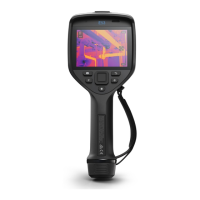
Do you have a question about the FLIR E series and is the answer not in the manual?
| Accuracy | ±2°C or ±2% of reading |
|---|---|
| Field of View (FOV) | 45° × 34° |
| Spectral Range | 7.5 - 13 μm |
| Image Modes | Thermal, MSX (Multi-Spectral Dynamic Imaging), Picture-in-Picture |
| File Format | JPEG |
| Battery Type | Li-Ion battery |
| Operating Temperature | -15°C to +50°C |
| Storage Temperature | -40°C to +70°C |
| Connectivity | USB |
| Water and Dust Resistance | IP54 (IEC 60529) |
Explains semibold, italic, monospace, and uppercase usage in the manual.
Recommends annual calibration and waiting periods for accurate measurements.
Instructs on environmentally friendly disposal of electronic products.
Lists all components included with the infrared camera.
Identifies components visible from the right side of the camera.
Identifies components visible from the left side of the camera.
Explains the function of each button and the touch-screen LCD.
Identifies components visible from the bottom of the camera.
Explains LED signals for battery status and camera power.
Details the procedure for turning the laser pointer on and off.
Step-by-step guide to power on the camera using the power button.
Step-by-step guide to power off the camera using the power button.
Explains how to view an image before saving it to check its content.
Step-by-step guide to configure thermal fusion settings for image analysis.
Step-by-step guide to configure picture-in-picture display for thermal imaging.
Guides on adding measurement tools such as spots, areas, and boxes to the image.
Outlines a procedure for using Extech meters and infrared cameras for moisture detection.
Guides on setting up humidity and insulation isotherms for building analysis.
Explains how to capture a digital photo to accompany an infrared image.
Explains how to clean the camera body, cables, and accessories.
Provides key dimensions for the camera, including front and side views.
Shows dimensions for the 30 mm/15° and 10 mm/45° infrared lenses.
Displays dimensions for the camera battery and its charger.
Shows how to detect moisture and water damage using infrared imaging.
Demonstrates identifying faulty electrical contacts through thermal imaging.
Illustrates identifying oxidized electrical sockets by their thermal signatures.
Explains how to identify insulation issues in building structures using infrared.
Demonstrates identifying air drafts in buildings via thermal imaging.
Includes copyright notices and disclaimers for building thermography content.
Covers training needs, building codes, and model-specific function availability.
Offers essential guidelines for thermographic inspections, including emissivity and verification.
Provides guidance on detecting moisture, mold, and water damage in buildings.
Offers guidance on detecting air infiltration and insulation issues in building structures.
Details moisture detection techniques specific to low-slope commercial roofing.
Includes copyright notices and disclaimers for building thermography content.
Offers essential guidelines for thermographic inspections, including emissivity and verification.
Provides guidance on detecting air infiltration and insulation issues in building structures.
Details moisture detection techniques specific to low-slope commercial roofing.
Covers energy-efficient construction, insulation, and airtightness principles.
Alerts users about model support and country-specific electrical regulations.
Guides on how to properly set up the infrared camera for accurate electrical inspections.
Explains how to distinguish reflections from actual hot spots in thermal images.
Explains how wind affects temperature measurements and provides correction factors.
Advises on waiting for the camera to acclimatize to temperature changes for correct measurement.
Covers training, customer support services, and glimpses into FLIR's operational facilities.
Introduces infrared measurement principles and required object parameters.
Details two methods (Direct and Reflector) for finding reflected apparent temperature.
Details Herschel's accidental discovery of infrared radiation and his early experiments.
Introduces thermography concepts and the electromagnetic spectrum.
Describes the division of the electromagnetic spectrum into wavelength bands.
Explains the concept of blackbody radiation and its characteristics.
Explains Wien's law relating color temperature to wavelength and its mathematical formula.
Describes Stefan-Boltzmann's law relating total emissive power to absolute temperature.
Discusses processes affecting real objects' radiation compared to blackbodies.
Explains the effective emissivity of semi-transparent materials.
Defines the voltage terms (Uobj, Utot, Urefl, Uatm) used in the measurement formula.
Lists literature and FLIR Systems measurements used for emissivity data.
Advises caution with emissivity values; they are for shortwave cameras and are recommendations.
Compiles emissivity values for materials, temperatures, and spectra.